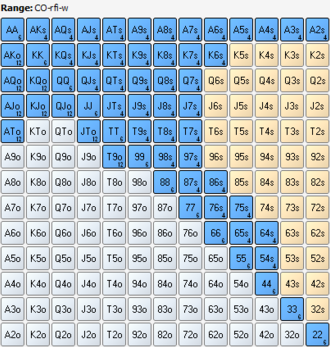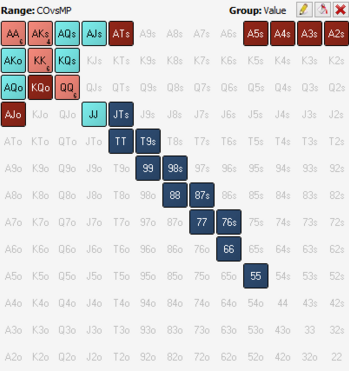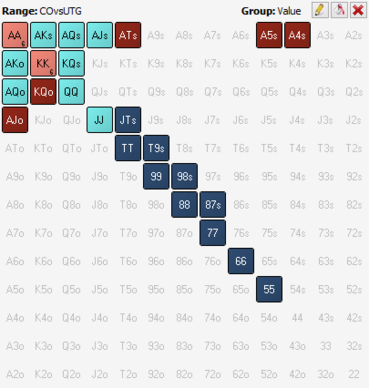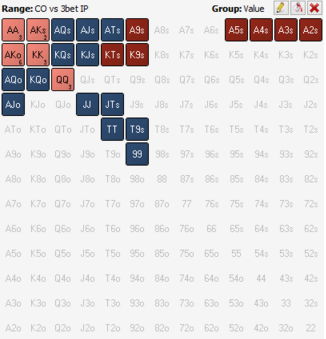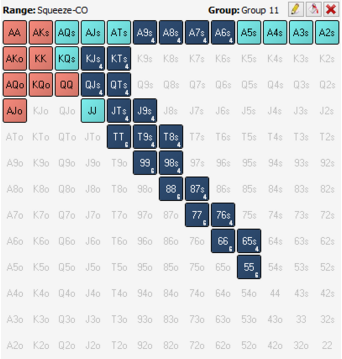Playing a wide range of hands from the cut off position leaves a lot of areas to optimize your play. Make sure you're getting the most value from this spot.

Sometimes players are so obsessed with their button play that they forget that the CO is also an extremely profitable situation at the table when played correctly.
If we can get our CO winrate to around 20bb/100 we are doing very well.
Unlike the button, we are not guaranteed position when we open raise.
The button is in a very powerful position and
can 3bet us aggressively knowing that he will always have position postflop. For this reason
we should be playing a significantly tighter range from the cut-off than we do the button. In some scenarios the button is overly tight however, and in extreme cases we can treat the cut-off more or less like a second button.
CO – Raise First In Ranges
The raise first in range here represents 26% of all starting hands. This is significantly tighter than the button where we routinely open about 48% of starting hands. Anywhere between 2.2bb and 3bb can be used as our standard open raise sizing. It doesn’t make too much difference which sizing we pick, but the smaller we open, the larger the amount of hands we can open in theory. A smaller open sizing also makes it a little easier to deal with aggressive 3betters either on the BTN or in the blinds.
CO – Defending Against Opens

In many cases a 3bet from the CO will shut down action from the BTN and blinds assuming they don’t hold a premium. 3betting can be a good strategy since we will often take the pot down preflop or end up heads-up in position postflop.
We should still 3bet tighter from the CO than the BTN however for 2 reasons.
- We have 3 players to act behind us rather than 2. Even if these players are passive there is a slightly higher chance that one of them will wake up with a premium holding.
- Our 3bets will be against MP and UTG who will typically have a strong opening range. When on the BTN we will also be able to target the CO’s opening range which is relatively weaker than opens from early or middle position.
Similar principles apply to cold-calling. We have a reasonable shot at acquiring position, but ultimately it is significantly less likely than a situation where we are on the BTN and
are guaranteed to have postflop position whatever happens.
CO vs MP
- Light-Red – 3bet for value
- Dark-Red – 3bet as a bluff
- Dark-Blue – Cold-call
- Light-Green – Mix strategy, sometimes 3bet, sometimes cold-call
CO vs UTG
Notice that when playing against UTG, our defending ranges are a little tighter, but not significantly so. There won’t be a huge difference between the two scenarios. The average UTG player opens 14% of hands while the average open-raising range from MP is 18%.
 The reason we cold-call only 55+ is because we have 3 players behind who may decide to squeeze. Assuming we are on the BTN we will defend all pocket-pairs regardless of the position of the opener.
The reason we cold-call only 55+ is because we have 3 players behind who may decide to squeeze. Assuming we are on the BTN we will defend all pocket-pairs regardless of the position of the opener.
The mixed hands can be approached with roughly a 50/50 ratio. So assuming we are in the CO and face an MP open while holding AKs, we can sometimes 3bet, sometimes cold-call. The reason we play like this is that typically 3betting will have a higher expectation than cold-calling. Assuming we 3bet all of the hands in light green however, we might open ourselves up to exploitation. Against extremely passive opposition we would likely get away with 3betting all of the hands in light-green with 100% frequency.
Defending Against 3bets
There are 3 possible players who can 3bet against us, BTN, SB, and BB. Our defending ranges might look as follows.
This scenario is when we face a 3bet from either of the blinds. Our defending strategy will be somewhat similar in both scenarios.
- Light Red – 4bet for value
- Dark Blue – Flat call, play IP
- Dark Red – 4bet bluff
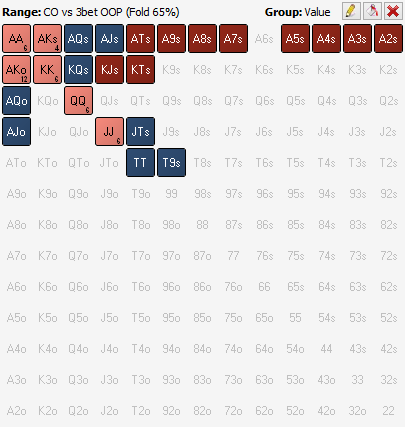
Notice again that there is not a huge difference between the 2 defending ranges. We should generally defend a little tigher when OOP vs a BTN 3bet, but keep in mind that the BTN’s 3betting range is often wider than that of the blinds, so we don’t need to defend too much tighter.
Some of the hands around the edge of the flatting range OOP, KQo, AJo, KJs, 9Ts, JTs, might be a little marginal as flats,
so it really depends on the opponent to an extent. In lower limit games it’s fine to defend a range a little tighter than the one outlined.
Overcalling/Squeezing
This situation won’t happen overly frequently as we specifically need UTG to open and MP to cold-call. We can typically overcall a little bit wider than we would normally cold-call assuming we were facing a regular UTG open.
Light red – Always Squeeze
Light-Green – Squeeze or Overcall
Dark-Blue – Overcall
Seeing as there is a chance that we get squeezed by the button if we simply overcall, our overcalling will be noticeably tighter than the button overcalling
range when facing an open and a call.
Sizings
The cold-calling/overcalling/squeezing ranges have been designed with a 3x open-raise in mind. These should be adjusted significantly based on variations in the size of the open. Vs a smaller raise we defend noticeably wider, while vs a larger raise we defend noticeably tighter.
 As such these ranges should be used as a rough guide
As such these ranges should be used as a rough guide and should be deviated from based on the sizing we face and the type of opponents we play against. Some of the hands will also perform better or worse based on the effective stacks. Generally speculative hands do poorly when the stack sizes are shallow, but play well when the stack sizes are deep. TPTK type hands such as AQ do better when the stacks are shallow and perform less well when the stacks are deep.
Let me know your thoughts in the comments below!
Other Top Recommended Content
If you enjoyed reading this article, check out our other top recommended articles...
Or take a look at some PokerVIP coaching videos...

